A Mite-y “What the … ?” Give Away
I wanted to be smart and funny with “What the … ?” but I quickly realized that I’d given away the answer in the subject line of this week’s newsletter. Oh, well, y’all are smart and can figure out the answer to the mystery quickly anyway.
So, there, the creature that caused the chlorotic poinsettias below is Lewis mite.
Many folks are finding Lewis mites on this year’s poinsettia crop. I was in the Chesapeake Bay area recently, and yup, they have Lewis mite. I was in Texas and some growers there have issues, too. I heard from folks in Alabama and California, and they got them suckers, too. It seems like Lewis mite infestations are blowing up throughout the country.
I totally agree with Sarah Jandricic of Ontario Ministry of Food, Agriculture and Rural Affairs (OMAFRA) when she said in her post, “Lewis mite is one of those pests that seems to go in cycles—some years we don’t see it at all, and some years I get reports as early as August.”
So, why is this year particularly bad? I hate to point the finger, but I think we might have to trace the problem to propagation. I don’t think I’m unfair; Lewis mite simply doesn’t just show up from nowhere. Unless you have an untreated strawberry field nearby (another improbability—strawberry in the summer??), there isn’t a major source of Lewis mite inside or outside of the greenhouse. (I read about roses being hosts, but I haven’t seen or heard of a case of that myself.)
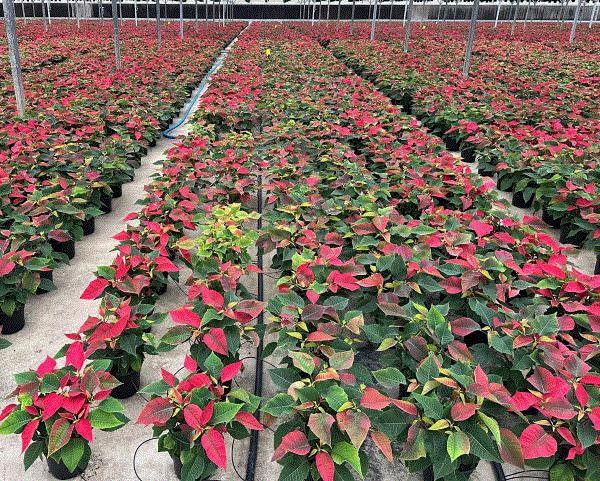
Pick out one poinsettia in this block that is infected by Lewis mite.
Both twospotted spider mite and Lewis mite cause stippling, chlorosis and distortion, but there are some differences between the two. Unlike in strawberry, where Lewis mite and twospotted spider mite can appear at the same time, spider mite infestation on poinsettia is often caused by Lewis mite. (Go HERE for a quick guide on how to distinguish twospotted spider and Lewis mite from my friend Surendra Dara of the University of California.) I also find Lewis mite to be “lazier” than twospotted spider mite—Lewis mite spread very slowly as if they really don’t want to take that extra step. So, Lewis mite infestation in a crop always look more patchy or isolated to me.

How to Kill Lewis mite?
Let’s talk about how to kill them. Let me say it from the start—It’s harder than you think.
There are a few complications with management of Lewis mite on poinsettia. Bracts are coloring up during this time of the year so I’m usually more careful about recommending sprays (for mite, whitefly or any pest for that matter). Canopies are also close together, so we’ll need to find a way to deliver the spray solutions deep inside the canopies and to the underside of leaves. (The same principle of good canopy penetration still apply for translaminar miticides.) And lastly, we simply don’t know much about the efficacy of miticides against Lewis mite.
Unlike the twospotted spider mite, Lewis mite is an occasional pest and only on poinsettia. So, there aren’t many ornamental entomologists who spend the effort to keep a colony and study how to control them. I did a quick and small trial eight or 10 years ago, when I chanced upon an infested poinsettia crop, and found Akari (fenpyroximate; IRAC 21A), Avid (abamectin; 6), Floramite (bifenazate; 20D), Pylon (chlorfenapyr; 13), and Sultan (cyflumetofen; 25) as effective. Of course, Pylon isn’t registered for use on poinsettia; I threw that in my trial for the fun of it. The other miticides are safe on bracts, but you should always test for crop safety on the poinsettia varieties you’re growing before spraying.
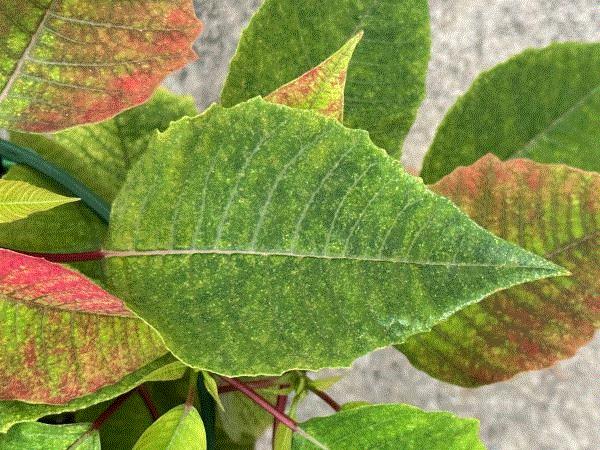
Stippling and chlorosis by Lewis mite.
Not having a whole lot of experience in floricultural crop to go on, I searched for efficacy data on controlling Lewis mite on other crops. Studies on raspberry and strawberry suggested that hexythiazox (Hexygon; 10A; ornamental trade names are in parenthesis), spiromesifen (Savate; 23), and fenbutatin-oxide (Vendex; 12B) are also relatively effective options. Vendex specifies application only prebract.
Biological control seems like a solution if we don’t want to spray. The best options for Lewis mite are the predatory mites Neoseiulus californicus and Neoseiulus (or Amblyseius) fallacis. Biological control is best started in the crop early, preferably soon after sticking. Because of the patchy distribution of Lewis mite infestation, biological control may be able to keep mite populations down on asymptomatic plants, requiring you to use a smaller amount of miticide and time to treat plants that are showing stippling only. Check for compatibility of miticides with these predatory mites if you need to do a spot treatment.
Knowing or suspecting that the mites came in with the cuttings, we should consider treating the cuttings with a pre-planting dip before sticking. Although there’s no data on the efficacy of pre-planting dip against Lewis mite, I expect the dip option for whiteflies, such as 0.1% horticultural oil, to work well against Lewis mite, too. I found pre-planting dip with Hexygon was effective against twospotted spider mite on seedlings; I think this option may also work.
Go HERE for Sarah Jandricic’s take on managing Lewis mite on poinsettia.

New Hurricane Aids
Last e-newsletter I introduced AmericanHort’s “After The Storm” website, which collects resources for growers, workers and operations affected by the recent hurricanes in the southern United States. This website could be a one-stop shop for those looking for help from local, state and federal resources.
New assistance is coming to the affected communities.
AgriSafe’s FarmResponse Program is offering training to mental health professionals working on supporting the agricultural communities affected by the storms. The on-demand, 3.5-hour continuing education course will provide understanding of rural and agricultural culture and mental health models and cover important topics such as suicide and substance abuse prevention. Go HERE if you are a mental health professional interested in receiving the training.
USDA announced $233 million in indemnity payments to farmers impacted by Hurricane Helene. As part of the Hurricane Insurance Protection-Wind Index program, the payments are to help with the recovery efforts. The payments are allocated to Alabama ($5 million), Florida ($12.8 million), Georgia ($207.7 million), North Carolina ($4.1 million), South Carolina ($4.1 million) and Virginia ($61,000). Go HERE to find more information about this insurance indemnity program.
Producers in Florida impacted by hurricanes Debby, Helene and Milton will receive $26 million in assistance from USDA’s Natural Resources Conservation Service under the Emergency Environmental Quality Incentive Program (EQIP). EQIP provides technical and financial assistance to producers and forest landowners in developing and implementing conservation plans. Applications are being accepted until December 20. Go HERE for information.

The Spanish 2025 IMF is Available
The Spanish version of the 2025 Insecticide, Miticide and Fungicide Guide is available. Go HERE if you also want an English version, which is available since September.
In addition to the insecticide and fungicide lists, you’ll also get a preemergence herbicide guide and quite a few special content items that are available in the English version. The articles on downy mildew by Francesca Hands of The Ohio State University and on disease diagnosis by Tom Creswell and John Bonkowski of Purdue University contain fundamental knowledge on disease diagnosis and epidemiology.
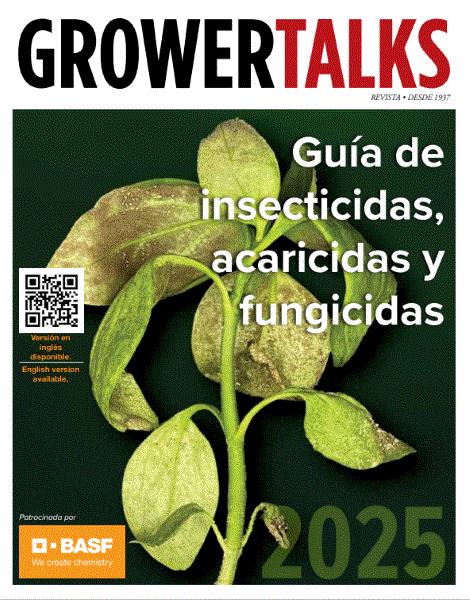
This will be a great resource to share with your Hispanic staff and have them brush up on some essential pest management skills.
I thought initially that I can learn some Spanish by reading the Spanish 2025 IMF Guide and comparing to the English version. It’s way too advanced for me.
SaniDate WTO Approved for Organic Irrigation Water
Folks who produce organic fruits and vegetables now have a new option for controlling harmful human pathogens in irrigation water. BioSafe Systems announced a couple of weeks ago that SaniDate WTO, which contains hydrogen peroxide (23%) and peroxyacetic acid (5.3%), has received approval for its label update for controlling toxin-producing E. coli and Salmonella in preharvest organic irrigation water. This would be an attractive alternative to chlorine treatment of organic irrigation water.
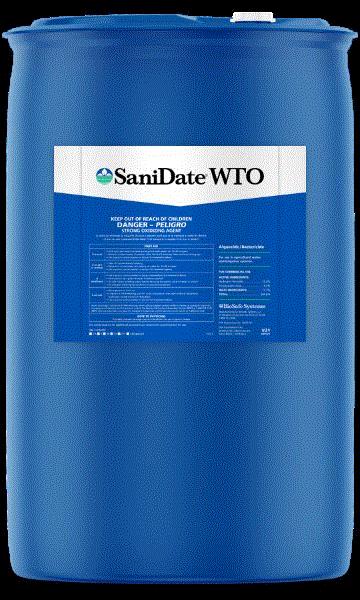
SaniDate is the only organic product available for treatment of harmful bacteria in irrigation preharvest water. SaniDate WTO is OMRI-listed and has a restricted entry interval (REI) of one hour when used as a spray in enclosed structures (including greenhouses), zero hour when used as a dip or drench, and until the spray has dried in field application.
Go HERE for more information about SaniDate WTO.
Paul’s Battle With Rats
I don’t want to rat Paul Pilon out, but he wrote a very timely segment on rodents in last week’s Perennial Pulse, particularly on preventing and managing rodents in overwintering facilities.
I didn’t realize rodents can do so much damage in potted plants until seeing the picture below, which shows the damage they can do to phlox under protective blanket. I don’t have to do much winter protection for my perennial plants on the coastal plains of South Carolina. Only occasionally do I need to have them covered.
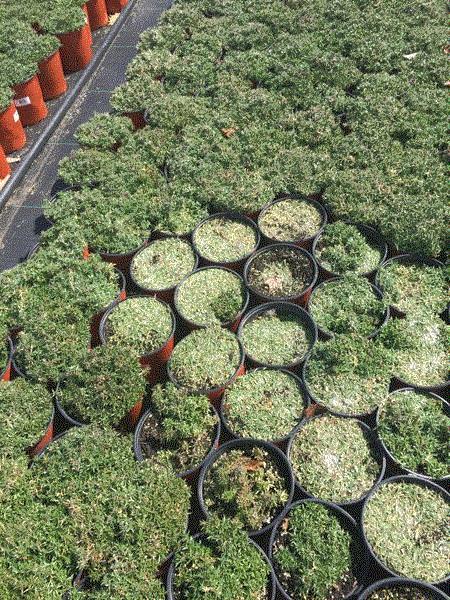
For folks who overwinter perennials, a rodent management plan under protective covering seems to be a must. You can use repellents, which constitute mainly smelly essential oils. Or you can use baits. Paul has the solutions for you. So go HERE to read Paul’s column on preparing for rodents in the winter.
Disease Management Course to Start Next Week
The Practical Disease Management course, a part of the University of Florida’s Greenhouse Training Online Program, will start on November 11. You still have a chance to find out more and to register for the course by going HERE.
This course will be taught by Carrie Harmon at the University of Florida and will include topics such as disease prevention, environmental management options, organic and conventional management options (including fungicides), pesticide safety, etc.
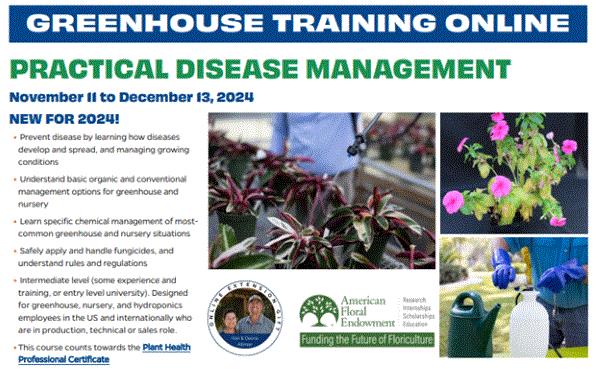
Want to know how to control the top 10 diseases you’ll likely face in greenhouses and nurseries? Want to earn credits toward a Plant Health Professional Certificate? This is the course for you. This online, four-week-long, go-at-your-own-pace course is offered in both English and Spanish. The cost is $275 per person, with a 20% discount when enrolling five or more people.
See y'all later!

JC Chong
Technical Development Manager at SePRO
Adjunct Professor at Clemson University
This e-mail received by 27,847 subscribers like you!
If you're interested in advertising on PestTalks contact Kim Brown ASAP!